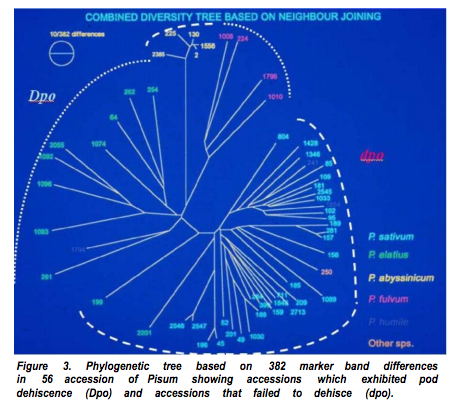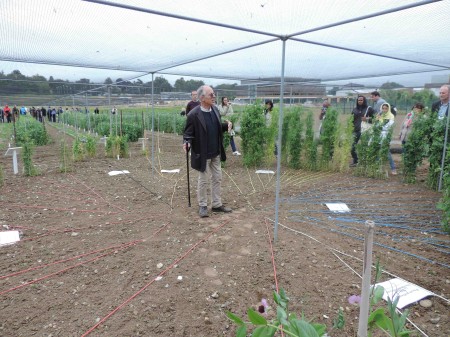- New UNESCO World Heritage Sites, including some vaguely agricultural ones.
- Why more of those would make sense.
- Though monitoring would be a challenge.
- Could put it all in genebanks, like these mangoes in India.
- But that’s hard too, just ask this coconut genebank curator in PNG.
Brainfood: Old flax, Rice in Spain, Rice in Iran, Mozambican cowpea, Agrobiodiversity reserve, Old olives, Georgian livestock, Crowdsourcing fungi
- Harvesting wild flax in the Galilee, Israel and extracting fibers — bearing on Near Eastern plant domestication. The wild stuff was harvested before the Neolithic Revolution.
- Building resilience to water scarcity in southern Spain: a case study of rice farming in Doñana protected wetlands. Better to restore part of the rice fields to natural wetlands.
- Evaluation of rice dominance and its impact on crop diversity in north of Iran. Rice can’t catch a break in Iran either.
- Evaluation of four Mozambican cowpea landraces for drought tolerance. One of them is promising.
- Agro-Biodiversity Spatial Assessment and Genetic Reserve Delineation for the Pollino National Park (Italy). Somewhat gratuitous use of GIS, as far as I can see, but pretty maps.
- A comparative analysis of genetic variation in rootstocks and scions of old olive trees — a window into the history of olive cultivation practices and past genetic variation. Much more variation among rootstocks than scions.
- The diversity of local Georgian agricultural animals. I’d like to see a Megrelian horse one day, they sound cool.
- Crowdsourcing to create national repositories of microbial genetic resources: fungi as a model. Why just fungi, though?
Pisum phylogeny illustrated in really cool way
Yeah, sure, you can publish your Pisum phylogenetic tree the usual way:
But isn’t it a whole lot better to do it like this?
That’s the author, Mike Ambrose of the John Innes Centre Germplasm Resources Unit showing off his handiwork. Thanks to Nora Castañeda for the photo. It’s all happening because of the PGRSecure conference in Cambridge, UK. which you can follow on Twitter.
LATER: And thanks to Jim Croft for pointing out something similar from Down Under.
Brainfood: Open sesame, Turkish buffalo, Crops & diets, Tuberous-rooted chervil, Pine breeding, Pigeonpea diversity, Sorghum adoption, Slumdog trees, Regenerating wild sunflower
- Sesame Crop: An Underexploited Oilseed Holds Tremendous Potential for Enhanced Food Value. Nice overview of diversity conservation and use. Lots of scope for improvement.
- Microsatellite based genetic diversity among the three water buffalo (Bubalus bubalis) populations in Turkey. No great evidence of differentiation among populations into breeds, unlike in India, say.
- Crop diversification, dietary diversity and agricultural income: empirical evidence from eight developing countries. More crops grown, more dietary diversity.
- Temporal evolution of the genetic diversity of Chaerophyllum bulbosum: Consequences on the genetic resources management. French article on the lack of hydrographic structuring, or erosion, in the genetic diversity of largely forgotten apiaceous root vegetable in Germany.
- Merging applied gene conservation activities with advanced generation breeding initiatives: a case study of Pinus radiata D. Don. Because introduction of new diversity from native areas is difficult, foresters in non-native areas should better understand and use the diversity in existing provenance/progeny trials.
- Comparative Analysis of Genetic Diversity among Cultivated Pigeonpea (Cajanus cajan (L) Millsp.) and Its Wild Relatives (C. albicans and C. lineatus) Using Randomly Amplified Polymorphic DNA (RAPD) and Inter Simple Sequence Repeat (ISSR Fingerprinting. 16 Indian accessions classified in 3 clusters, with the stress resistant material mostly together. More diversity in the wilds.
- The role of varietal attributes on adoption of improved seed varieties: the case of sorghum in Kenya. Not just about yield.
- Vegetation in Bangalore’s Slums: Boosting Livelihoods, Well-Being and Social Capital. What’s needed is trees with short stature, narrow trunks, medium canopy, high value. How many species like that can you think of?
- Comparison of fatty acid composition of oil from original and regenerated populations of wild Helianthus species. It’s not the same.
Nibbles: Colombian chocolate, Urban ag, Subaks, GM debate, Taxonomy online, Genebank tools online, BBC on Kew, Australian seed bank, Cedar of Lebanon, Pizza philosophy, Feijoada
- Move over Juan Valdez. Cacao farmers want to emulate a marketing icon.
- Urban agriculture not all it’s cracked up to be. Living up to that urban ag icon, Cuba, is hard.
- Bali’s iconic, traditional subaks are a complex adaptive system, and much better than modern rice farming alternatives. Makes you wonder why they need protecting, though.
- GM bananas will save us. Not by themselves they wont. I don’t know why I keep linking to this stuff. Nothing at all iconic about it.
- Iconic taxonomic revision tools online.
- Something else that’s online is a bunch of tools for analyzing genebank data. Soon to be iconic, no doubt. As soon as people use them. So get cracking.
- Huge BBC documentary on Kew coming up. I bet the iconic Millennium Seed Bank will feature.
- Speaking of iconic genebank buildings, today’s one comes from Australia.
- The history of an iconic Middle Easter tree?
- The philosophy of an iconic Italian delicacy. Well, Neapolitan, really.
- And in honour of the World Cup (I refuse to put FIFA in front, let them sue me), an iconic Brazilian dish. And don’t worry, those beans are safe. Somewhere iconic.

